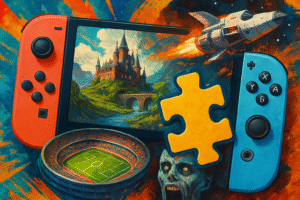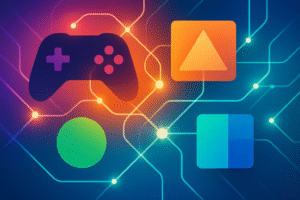For years, Nintendo fans have faced a familiar dilemma. A groundbreaking console, innovative gameplay, but a nagging question mark over third-party support. Major multiplatform titles often bypassed Nintendo hardware entirely, or arrived as compromised, delayed ports. This wasn’t just an inconvenience; it was a fundamental limitation that kept many gamers from fully embracing Nintendo’s platforms. But with the highly anticipated Nintendo Switch 2, it appears those days are finally behind us. Nintendo is not just catching up; it’s actively exorcising the ‘third-party problem’ that has plagued its consoles for generations.
The Echoes of the Past: Why Third-Party Support Was a Struggle
The original Nintendo Switch, while a marvel of hybrid design, often struggled with the technical demands of modern multiplatform games. Its hardware, while perfectly suited for Nintendo’s first-party titles and many indie gems, simply couldn’t keep pace with the graphical fidelity and processing power required by AAA releases. This led to a frustrating cycle:
How to Buy DJI Osmo 360 US (2025): A Retailer Guide
•Skipped Releases: Many developers opted to skip the Switch altogether, focusing on the more powerful PlayStation, Xbox, and PC ecosystems.
•Cloud Versions: For some demanding titles, Nintendo offered ‘cloud versions,’ which required a constant, stable internet connection to stream the game. These were widely criticized for input lag, visual compromises, and general unreliability, offering a subpar experience compared to native versions.

•Delayed Ports: Even when games did make it to the Switch, they often arrived months or even years after their initial launch on other platforms. By then, the hype had died down, and many players had already experienced the game elsewhere.
Titles like Control serve as prime examples, arriving long after their initial buzz, leaving Nintendo enthusiasts feeling like second-class citizens in the gaming world. This historical context is crucial to understanding the significance of the Switch 2’s new approach.
A New Era: Day-and-Date Releases and Unprecedented Support
The recent Nintendo Direct Partner Showcase offered a powerful glimpse into the future, showcasing a commitment to third-party integration that is truly unprecedented for Nintendo. The message is clear: the Switch 2 is designed to be a platform where major titles can launch simultaneously with their counterparts on other consoles. This isn’t just about getting games; it’s about getting them on time and in full fidelity.
Consider these compelling examples:
•Cronos: The New Dawn: This third-person survival horror game from Bloober Team (known for their work on the Silent Hill 2 remake) is precisely the kind of graphically intensive title that would have been unthinkable on the original Switch. Yet, it’s slated for a September 5th launch on the Switch 2, the very same day it hits PlayStation, Xbox, and PC. This is a monumental step, signaling a new baseline for third-party compatibility.
•Madden NFL 2026: A true return to form! After more than a decade, a mainline Madden title is finally returning to a Nintendo console. More importantly, Madden NFL 2026 will launch across all platforms simultaneously on August 14th. This is a massive vote of confidence from Electronic Arts, a publisher whose support has historically been inconsistent on Nintendo platforms.
•Star Wars Outlaws: While not a day-one release, the arrival of last year’s critically acclaimed Star Wars Outlaws this September is a significant indicator of the Switch 2’s capabilities. This open-world adventure from Ubisoft is arguably one of the most technically demanding titles to ever grace a Nintendo system, demonstrating the new hardware’s ability to handle recent, graphically rich experiences.
•Borderlands 4: The popular looter-shooter franchise is also making a timely appearance. Borderlands 4 will launch on the Switch 2 just three weeks after its PC and console counterparts. A three-week delay is a stark contrast to the year-long waits that were once common, showcasing a dramatically improved development pipeline.

The Horizon: More Heavy Hitters on the Way
The confirmed lineup extends beyond these immediate releases, painting an even brighter picture for the Switch 2’s future. We already have confirmation of major, technically ambitious games making their way to the platform:
•Elden Ring Tarnished Edition: The critically acclaimed open-world action RPG that took the gaming world by storm is set to arrive on the Switch 2. This is a game renowned for its vast environments, intricate details, and demanding combat, making its presence on a Nintendo console a testament to the new hardware’s power.
•Final Fantasy VII Remake: Square Enix’s stunning reimagining of a beloved classic, known for its breathtaking visuals and complex character models, is also confirmed. This further solidifies the Switch 2’s position as a viable platform for visually impressive JRPGs.
•The Duskbloods: FromSoftware’s new multiplayer title, shrouded in mystery but promising their signature challenging gameplay, is another exciting addition. The fact that such a prominent developer is bringing a new, potentially demanding online experience to the Switch 2 speaks volumes.
These are the kinds of
games that were once considered impossible on a Nintendo console, often described as “big-ass, pretty-ass, particle-y effect-ass” titles that demand significant graphical horsepower. The Switch 2 is clearly designed to handle them.
The Million-Dollar Question: Will the Ports Be Good?
Launching games simultaneously is a huge step forward, but the ultimate success hinges on the quality of these ports. A day-and-date release means little if the game runs poorly, suffers from significant frame rate drops, or is visually compromised to an unacceptable degree. This is the crucial question on every gamer’s mind. While we must await official reviews and hands-on experiences, there’s a powerful precedent that offers significant reassurance: the critically acclaimed Nintendo Switch 2 port of Cyberpunk 2077.
Cyberpunk 2077 is a notoriously demanding game, even on high-end PCs and current-generation consoles. Its successful and well-optimized port to the Switch 2 demonstrated that developers can indeed bring massive, complex open-world titles to Nintendo’s new hardware without catastrophic compromises. This wasn’t a watered-down experience; it was a testament to the Switch 2’s improved capabilities and the optimization efforts of the development teams. This single example has set a high bar and instilled confidence that future third-party releases will follow suit.
Conclusion: Nintendo Joins the Third-Party Party, On Time
Nintendo has always carved its own path, prioritizing innovative gameplay and unique experiences over raw graphical power. The original Switch embodied this philosophy, creating a beloved platform despite its hardware limitations. The Nintendo Switch 2, however, represents a strategic evolution. It’s not attempting to out-muscle a PlayStation 5 or an Xbox Series X in a spec-for-spec battle. Instead, it has evolved just enough to finally integrate seamlessly into the broader gaming ecosystem, allowing it to participate in the third-party party on time and with confidence.
For gamers, this is an undeniable win. It means access to a wider array of titles, fewer compromises, and the ability to enjoy the latest and greatest games on a Nintendo console without feeling left behind. The “third-party problem” is no longer a haunting ghost; it’s a vanquished foe, and the Nintendo Switch 2 is leading the charge into a new, more inclusive era of gaming.
Keywords: Nintendo Switch 2, third-party games, gaming, console, release dates, hardware, game ports, Cyberpunk 2077, Madden NFL 2026, Cronos The New Dawn, Star Wars Outlaws, Borderlands 4, Elden Ring, Final Fantasy VII Remake, The Duskbloods, gaming news, video games, SEO, unique content, foring.fun
